Today SevenPonds speaks with Tina Allen, the founder and director of Liddle Kidz™ Foundation, an organization that provides education and outreach in the areas of children’s health and nurturing touch. A recognized leader in the field of pediatric massage therapy, Ms. Allen brings a wealth of knowledge and experience to her work with children and families all over the world. She has worked to create pediatric massage programs in several major medical centers throughout the United States, including Mayo Clinic and Children’s Hospital Los Angeles, and is the author of the award-winning book, “A Modern Day Guide to Massage for Children.” She also leads a pioneering effort to bring nurturing touch to children in orphanages across the globe.
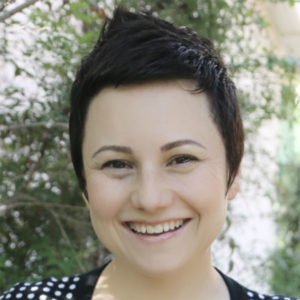
Tina Allen
Kathleen: Thanks so much for taking the time to speak with me, Tina. I know how busy you are, so I’ll dive right in. Can you tell me a little bit about your role as director of Liddle Kidz Foundation?
Tina Allen: As both the founder and director of Liddle Kidz Foundation, my role is very diverse. For example, I oversee employees and pediatric massage program development for hospitals and healthcare systems all over the world. I also develop much of the curriculum for our programs, and provide in-person education in infant and pediatric massage therapy for hospital and healthcare staff.
I stay actively involved in the day-to-day operations of Liddle Kidz in order to ensure the important mission and vision of the organization continues as I started it. We are expanding our services into healthcare and hospital settings at a rapid pace, implementing our programs in at least one or two new countries every year.
Kathleen: How did you become involved in pediatric massage therapy?
Tina: When I began my education, I didn’t intend to become a massage therapist. I majored in pediatric occupational therapy. I knew that I wanted to work with children in a health care capacity, but I had no interest in “poking and prodding” them. During the OT program, I discovered I would not learn very much about the use of integrative therapies. So I decided to seek out more education. That’s when I entered a massage program with the goal of adding massage therapy as an adjunct to my work as a pediatric OT.
As I pursued my studies in both disciplines, I soon learned that educators never discussed children when they talked about massage. It was at that moment that my interest in infant and pediatric massage was born.
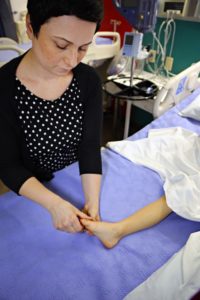
Tina provides massage therapy to a hospitalized child
Kathleen: I understand that you worked with HIV/AIDS patients back in the 1990s, when AIDS was still a major cause of death in the U.S. What was it like working with this population?
Tina: Working with these individuals was a great opportunity to provide massage therapy for those who would benefit most from touch.
At the time, there was significant stigma associated with a diagnosis of HIV/AIDS. Hands-on care providers took enormous precautions, as many believed you could contract the disease via touch. Patients were looked upon by many as “untouchable.” They were isolated and alone. Even parents felt uncomfortable touching their children if the child had AIDS, even when they had HIV themselves. There was so much fear around contracting the virus.
In my experience, giving touch therapy to people with HIV/AIDS provided not only the physical benefits we assume take place with the use of massage, but also the simple act of being touched without fear. The enormous emotional benefits this provided was beyond compare.
I remember one of my clients stating that he thought of me as his “window on the world.” He was a client that was non-ambulatory and had an AIDS diagnosis. It was difficult for him to even see out the window, and part of our session time included my talking to him about what I saw outside.
Kathleen: How did you begin to expand your pediatric massage program into hospitals? I imagine it isn’t easy to get your foot in the door.
Tina: No it is not! There is a lack of basic knowledge of the benefits of massage therapy, especially for children. In healthcare settings, specifically hospitals, I come across doctors and nurses who have no understanding of what massage therapy can do. They actually minimize its potential as a part of a comprehensive plan of care for pediatric patients.
When I come across this resistance, I find myself providing basic information. For instance, I educate them in the differences between massage in the spa setting versus massage in the hospital. I’ve made it my life’s goal to educate on the benefits of pediatric massage.
In working to establish a pediatric massage program, we need at least one staff member who becomes a champion. This person is the contact who aids us in presenting the program to administrative leaders, physician groups and nursing staff. Their help is key to implementing a program successfully.
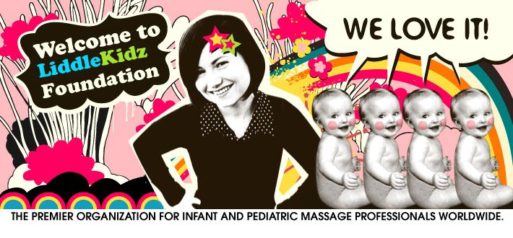
Credit: Little Kids Foundation.org
Kathleen: What type of massage is appropriate for hospitalized children, and what do you see as the primary benefit?
Tina: Children with chronic conditions or complex medical needs often develop fear and anxiety surrounding their medical care. They must cope with a variety of stressors, symptoms and side effects related to their illness and treatment. Facilitating healthy touch experiences within the medical system can help to restore trust. It also teaches children how to express their needs and generally improves their quality of life.
Pediatric massage is appropriate for almost any child in the hospital setting. For example, we use it for children who have heart conditions and cancer and kids in intensive care. It is also very useful in the palliative care setting, helping children at the end of life. Even very ill children appear to have less stress and anxiety, more energy and less pain after massage. Massage can also relieve constipation. That’s often an issue for children who are unable to get out of bed and move around or are on certain medications.
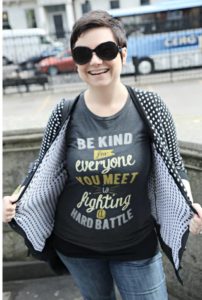
Tina Allen travels all over the world to spread the word about nurturing touch.
Kathleen: It seems that pediatric massage therapy is extremely beneficial to children with serious and even life threatening illnesses. Can it also be helpful for babies or even premature infants in the neonatal ICU?
Tina Allen: Research demonstrates that nurturing touch is critical to the development of psychological well-being. It becomes even more important when a baby is born prematurely.
Preterm infants and their parents and caregivers face some serious challenges. One of the most significant is bonding. Normally, an infant bonds with its mother or primary caretaker through close physical contact and nurturing touch. But in the NICU, there is limited physical contact between caregivers and the baby due to the child’s medical needs, doctor’s rounds, equipment and the like.
When a baby is very immature, it’s not appropriate to begin providing pediatric massage immediately. Rather, we recommend that parents and staff employ nurturing techniques such as holding, cuddling and comforting. Once the infant is stable enough, limited skin-to-skin contact provides appropriate stimulation and encourages bonding between parent and child.
This skin-to-skin contact may be in the form of placing the baby securely on the parent’s chest, a technique known as Kangaroo Care. A very simple but powerful intervention, it has been shown to stabilize preterm infants and improve outcomes overall.
When we do begin to introduce massage therapy for premature infants, we follow very specific guidelines and protocols. The baby must meet minimal weight and neurological requirements before we can begin. With that said, recent research suggests that the benefits of pediatric massage for preterm infants outweigh the potential negative effects of overstimulation. So, someday those protocols may change.
Infant massage provides many benefits. For example, it can:
- Facilitate weight gain in preterm infants
- Lower levels of the stress hormone, cortisol
- Increase muscle tone
- Improve sleep/wake patterns
- Shorten hospital stays
- Enhance cognitive and motor development at 8 months of age
- Improve developmental scores over time
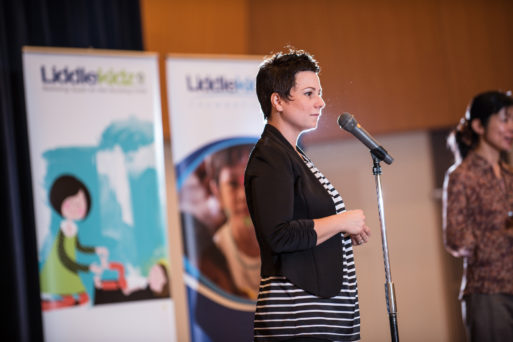
Giving a presentation in Japan
Kathleen: That’s incredible. It seems that massage and touch can benefit anyone at any age. Is it also beneficial for children on the autism spectrum or those with a sensory processing disorder?
Tina: Many people believe that children with autism do not like being touched. Although this is a common misconception, it is not always the case. Each child is unique. As pediatric massage therapists, we adapt our techniques and approaches to each child’s needs.
Therapeutic massage can be extremely beneficial for children with autism spectrum disorder or sensory processing disorders. However, these children perceive sensations differently, and may have anxiety about touch. Many of them are also very susceptible to sensory overload. This may stem from tactile hypersensitivities or because they previously experienced touch as painful or frightening.
When I advise healthcare providers about working with children with these kinds of disorders, I urge them to move cautiously and respect the child’s cues. It takes time to learn how the child responds to different sensory stimuli, such as types of touch, textures and lubricants.
Kathleen: Do you (or your volunteers) also provide massage for family members to help them cope with the stress of having a child who is seriously ill or dying?
Tina: Providing support to the entire family is at the heart of working in pediatrics. With pediatric massage therapy, we practice a family-centered approach. My philosophy is that if I can decrease the anxiety of everyone around the child, it also directly benefits the child.
So, yes, we encourage not only parents to receive massage therapy, but the medical and nursing staff as well.
Kathleen: I know that Liddle Kidz Foundation offers a number of certification programs for healthcare professionals. Do you also offer training for laypersons who may wish to volunteer or who simply want to learn how to use pediatric massage to help their own children when they’re in distress?
Tina: Family members are always welcome to take our courses. Massage therapy is an intervention that anyone who has the appropriate education can use at home. One of the goals of my work is to empower families to share nurturing touch with their children. Especially when someone is unwell, touch can be very comforting. And parents who know how to use massage to help their child feel more involved and more confident in providing care.
Kathleen: I’d like to switch gears now, and ask you about Liddle Kidz Foundation Global Outreach. I understand you have programs all over the globe. What, specifically, do you do?
Tina: As part of our mission, Liddle Kidz Foundation organizes groups of volunteers to provide hands-on care and education in many countries around the world. We focus on working with organizations and facilities that serve infants and children who have been orphaned or have special healthcare needs. Many of these settings have children ranging in age from babies born prematurely to adolescents.
The number of orphans around the world is astounding. [According to U.S. government estimates, 17.8 million children worldwide have no surviving parent]. There are so many children and so few caregivers. These children don’t have someone to run to their aid when they’re in need. They don’t have someone to hug them and hold them when they’re under stress. Children need to know someone out there cares about them. When this fundamental need goes unmet, all else is lost, and there is no hope of a viable future. It is our moral duty to help these children and let them know they matter.
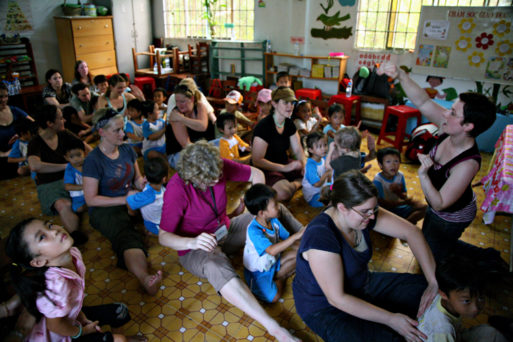
Tina teaches pediatric massage to the staff at a Vietnam orphanage.
Liddle Kidz Foundation Global Outreach doesn’t just provide hugs and cuddles, we create programs that are sustainable and replicable. Our experience has shown us that orphanages find it challenging to meet the emotional and developmental needs of children. And we know that the best way to support children’s healing is by supporting their caregivers as well.
Our goal, therefore, is to provide the children with nurturing touch while working directly with their caregivers to provide education and support. Thus, we provide healing tools to the caregivers who will stay and work with the children after we are gone.
Kathleen: How do massage and nurturing touch help parentless children?
Tina: Massage is beneficial to almost anyone, but children, in particular, have an essential need for touch. Touch stimulates our brains in many ways, most noticeably in the limbic cortex. That’s the area of the brain that generates emotions and allows us to make connections with others.
The benefits of massage therapy can be achieved during a relaxing 30-minute full body session, or simply by massaging the hands or feet for a few moments. When the staff in orphanages are educated on how best to provide touch therapy, they are more likely to use it as an intervention to improve the children’s health.
The health benefits of massage for children living in orphanages are truly enormous. For example, we trained the staff at one orphanage to use massage therapy with the children in their care. According to the orphanage director, prior to our first visit the staff took the children to the hospital at a rate of approximately 40 times per year. Now, two years later, after using the massage techniques consistently, they only take the children to the hospital around two to three times per year. The orphanage director credits the improvement in the children’s health to the use of pediatric massage.
Kathleen: What an impressive organization! I admire your work more than I can say. Thank you, Tina, for speaking with me today and for sharing your insights with our readers.

 What Is Pediatric Massage Therapy? An Interview with Tina Allen: Part One
What Is Pediatric Massage Therapy? An Interview with Tina Allen: Part One


 “Help Me, Helen”
“Help Me, Helen”
 Recovering Cremation Remains After the Los Angeles Fires
Recovering Cremation Remains After the Los Angeles Fires
 “As Tears Go By” by Marianne Faithfull
“As Tears Go By” by Marianne Faithfull














